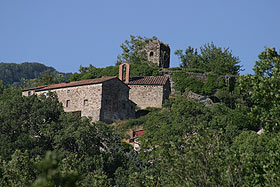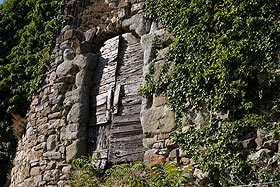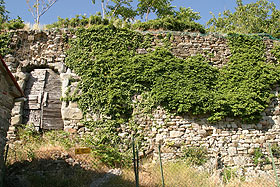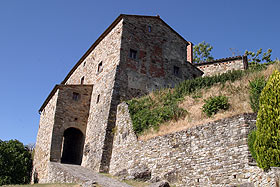Gressa Castle
 |
 |
1. The keep overlooking the hamlet from the
center of the inner ward. |
The castle of Gressa rise near Bibbiena, in the heart of the Casentino. Driving through the road that leads to the Franciscans Sanctuary of La Vernaafter about 4 km. we find on our left a deviation that conducts on a country road that ends just under the castle.
Click here to view a map of the castle
 |
|
The Bishop Palace with the gate of the outer walled enclosure. |
The castle of Gressa rises on a hill 585 meters high
near the homonym stream, overlloking the valley of the river Archiano,
not far from the city of Bibbiena. From this position is possible to
dominate the whole underlying territory. From the 1078 Gressa is named
on some documents as 'castrum', even if the first certain notices of
the castle and its owners date 13th century.
From the chronicles of that time the castle is indicated as ownership of the bishops of Arezzo, that used it as fortified summer residence. Due to its geographical position, surrounded from other Bishop's castles as Bibbiena, Marciano, Gello and from the Monasteries of Camaldoli and Prataglia, we can deduce that also its establishment is ascribable to the same Aretine bishops.
From documents of the 14th century we learn that the castle was besieged
and conquered by the Florentines in 1259. Afterwards the Aretine Bishops
taken back the fortification and in 1356 there was another, failed, Florentine
attack. It also seems that Gressa was the last of the castles of the
Casentino to remain in possession of the Bishops. The castle, today with
large parts in downfall and with urgent need of restoration, is constituted
by a external curtain wall with irregular polygonal plant, of which only
few lines remain, gifted of a beautiful gate in correspondence of the
Bishop's Palace. The Palace is in agood state of conservation thanks
to a recent restoration.
This curtain encircles the base of the hill. The second wall circuit is concentric to the first one and tightens the peak of the hillock. Also this enclosure has irregular form, assimilable to an octagonal polygon. In some points the walls reach five meters of high. The main gate of access to the core of the fortification was reachable through a timber staircase, today disappeared. To the inside rise, on the most elevated point, a tower with rectangular shape, developed on three floors, that had the functions of residence and military stronghold. The whole complex is built in sandstone and limestone of irregular form, to the exception of the angles, reinforced with big squared stone blocks. Between the two walls circuit are preserved two cisterns for the supply of water, whose inside masonry has covered from an impermeable plaster, a church and two civil buildings, whose structure has been altered by the recent restorations.
From the chronicles of that time the castle is indicated as ownership of the bishops of Arezzo, that used it as fortified summer residence. Due to its geographical position, surrounded from other Bishop's castles as Bibbiena, Marciano, Gello and from the Monasteries of Camaldoli and Prataglia, we can deduce that also its establishment is ascribable to the same Aretine bishops.
 |
|
The Bishop Palace with the gate of the outer walled enclosure. |
This curtain encircles the base of the hill. The second wall circuit is concentric to the first one and tightens the peak of the hillock. Also this enclosure has irregular form, assimilable to an octagonal polygon. In some points the walls reach five meters of high. The main gate of access to the core of the fortification was reachable through a timber staircase, today disappeared. To the inside rise, on the most elevated point, a tower with rectangular shape, developed on three floors, that had the functions of residence and military stronghold. The whole complex is built in sandstone and limestone of irregular form, to the exception of the angles, reinforced with big squared stone blocks. Between the two walls circuit are preserved two cisterns for the supply of water, whose inside masonry has covered from an impermeable plaster, a church and two civil buildings, whose structure has been altered by the recent restorations.
| View the castle Map |
| Back to Homepage |
| Back to Castles Index |